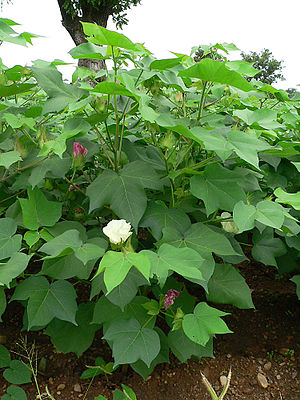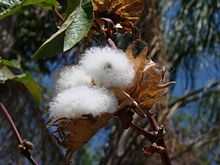Gossypium hirsutum
| Gossypium hirsutum | ||||||||||||
|---|---|---|---|---|---|---|---|---|---|---|---|---|

Gossypium hirsutum |
||||||||||||
| Systematics | ||||||||||||
|
||||||||||||
| Scientific name | ||||||||||||
| Gossypium hirsutum | ||||||||||||
| L. |
Gossypium hirsutum is a plant from the genus cotton ( Gossypium ). It comes from tropical America and is now widelygrownfor the production of cotton fibers.
description
Gossypium hirsutum is a perennial shrub that reaches a height of 1.5 to 2 m. In culture, the plant is grown as an annual and then becomes 60 to 150 cm high. The stem axis is green, occasionally tinged with reddish, it is covered with simple hairs that fall off over time. The leaves are three-lobed, rarely five-lobed, the top leaves sometimes unlobed. The leaf lobes are broadly triangular and end long drawn out. The leaf becomes 5 to 10 cm long, the width is slightly larger than the length. The leaf base is heart-shaped, the petiole is 3 to 10 (14) cm long. The petiole and the underside of the leaf are hairy, the top only sparse. The stipules are 0.5 to 1 cm long, they soon fall off.
The flowers are solitary in the leaf axils. The flower stalks are 1 to 1.5 centimeters long, they lengthen to 2.5 cm until the fruit is ripe. The outer calyx consists of three non-fused bracts . They are 2 to 4 cm long and 1.5 to 3 cm wide, hairy, with seven to nine pointed prongs at the front and heart-shaped at the base. The bowl-shaped goblet has five ciliate lobes. The petals are white to yellowish, reddish when they fade. They measure 4 to 5.5 cm in length by 3.5 to 4.5 cm in width, they are inverted egg-shaped. The Columna is 1 to 2 cm long.
The capsule fruit is three to five parts, oval, beaked at the front. It becomes 3 to 4 cm long and 2 to 3 cm wide. The oval seeds are 0.3 to 0.5 cm in size. They are surrounded by long white fibers and light gray, short, firmly adhering fibers.
The number of chromosomes is 2n = 52.
distribution
Gossypium hirsutum is native to tropical America, possibly from Mexico. It is cultivated worldwide in the tropics and subtropics. The four-fold chromosome set of Gossypium hirsutum comes from two different parent species ( allopolyploidy ). One part of the chromosome set is similar to that of the American species, the second part, however, to that of the African species. It is unclear when the crossing of the two original species took place: a point in time before the separation of Africa and South America (60-100 million years ago) or an exchange by humans a few hundred years ago was suggested. Molecular genetic studies, however, indicate that Gossypium hirsutum was 1 to 2 million years old; It is unclear how the exchange of the spatially separated output species took place today on different continents.
use
Gossypium hirsutum is the main supplier of cotton fibers . About 90% of global cotton production is based on G. hirsutum . The first cultivation probably took place on the Yucatán peninsula , from there it spread over Central America, the Caribbean to the north of South America. Early changes in breeding primarily concern the reduction of dormancy and rapid flowering unaffected by photoperiodism .
literature
- Ya Tang, Michael G. Gilbert, Laurence J. Dorr: Gossypium hirsutum . In: Wu Zhengyi, Peter H. Raven (Ed.): Flora of China . tape 12 . Missouri Botanical Garden Press, St. Louis, S. 297 ( eFloras.org - 1994+).
- Sultanul Abedin: Gossypium hirsutum . In: SI Ali, M. Qaiser (Ed.): Flora of Pakistan . tape 130 . Missouri Botanical Garden Press, St. Louis, S. 31 ( eFloras.org ).
Individual evidence
- ↑ a b c d The Biology of Gossypium hirsutum L. and Gossypium barbadense L. (cotton). (PDF; 1.1 MB) Australian Government, Department of Health and Aging, accessed January 13, 2011 .
- ↑ a b c Ya Tang, Michael G. Gilbert, Laurence J. Dorr: Gossypium hirsutum . In: Flora of China . Vol. 12, p. 297.
- ↑ a b Sultanul Abedin: Gossypium hirsutum . In: Flora of Pakistan . Vol. 130, p. 31.
- ^ Gossypium hirsutum at Tropicos.org. In: IPCN Chromosome Reports . Missouri Botanical Garden, St. Louis.
Web links
- Transgenes found in wild Mexican cotton ( Memento from February 29, 2012 in the Internet Archive )
- Gossypium hirsutum . In: U. Brunken, M. Schmidt, S. Dressler, T. Janssen, A. Thiombiano, G. Zizka: West African plants - A Photo Guide. Senckenberg Research Institute, Frankfurt am Main 2008.
